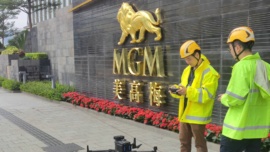Mysterious for several reasons: because the reason why there is still no train in Macau or why we started thinking about it so late is unclear.
MB November 2020 Special Report | Getting in and out
If it is possible to catch the train in Kowloon, and from there reach any Chinese city (or even outside China), why not do the same thing in Macau?
The truth is that, the plans to build a railway in Macau are at least a century old [see text on this pages], and it was only very recently that people started talking and thinking about it.
In mid-2017, a railway engineer from the mainland stated the obvious that no one else dared admitting: it is “technically feasible” for the national high-speed railway network to ultimately be connected to Macau.
Zhao Guotang, vice general engineer of China Railway Group Limited, delivered a speech at an event attended by local deputies, addressing the National People’s Congress (NPC) and local members of the National Committee of the Chinese People’s Political Consultative Conference (CPPCC), saying he believed that the national high-speed railway system will cover the Pearl River Delta in the future.
But, a year later, the then Chief Executive still said that the priority was “to prepare the project to link the future light rail with the high-speed rail network in China to connect Shenzhen, Zhuhai and Macau.”
At that time, Hong Kong inaugurated a high-speed rail line connecting Shenzhen and Guangzhou, and local deputy Si Ka Lon made his voice heard, proposing a train connection between Macau, Zhuhai, and Guangzhou.
At the end of that year, during the presentation of the Policy Address for 2019, the same Chui Sai On gave a first sign that the Government might be thinking of bringing the train to Macau: the head of government announced his intention to carry out combined studies in nine cities of the Chinese province of Guangdong aimed at integrating the territory into China’s high-speed rail system. “This link will accelerate integration into the national high-speed rail system,” he said.

But it was necessary to wait for Ho Iat Seng to come to power to see yet another advance in this process: last April, the new Chief Executive announced that in the future Macau will be connected to China’s high-speed rail network through the construction of an underwater tunnel connecting the city to the border post in Hengqin, as part of the development of LTR.
However, no other details are known at this time. Macau Business contacted Infrastructure Development Office (GDI) to try to get a better insight of the issue, but we were just told that “the Government is proceeding with the implementation study of the Hengqin Line of the Light Rail.”
Ku Wengkeong, Chairman of the Council of the Chartered Institute of Logistics and Transport in Macau, told Macau Business that “taking into account the urban spatial characteristics of Macau, the construction of high-speed rail stations and of the rails will occupy precious land resources in Macau; Macau simply doesn’t have the land mass to support high-speed rail stations, just take a look at the stations in Zhuhai.”
Professor Wengkeong added that “Macau should speed up the construction of the Hengqin Extension Line (to reach the Hengqin Port) and the East Line (linking Barrier Gate with the Taipa Line) in order to connect with the railway network in China. Therefore, the government should accelerate the construction of the Hengqin Extension Line and cooperate with the development in the west flank of the Greater Bay Area.”
However, it is necessary to take into account the recent statements made by the chairman of the Executive Committee of the Light Rail Society, Ho Cheong Kei, who acknowledged, in a public consultation session on the East Line, that the articulation between this transport and Zhuhai may not be ideal, as it will only pass through the Hengqin Border Post. There are several problems, including the issue related to borders.
In other words, the immediate priority is to allow the train to reach Hengqin, which is already connected to the national high-speed network and is one of six stops linking the Zhuhai train station with Zhuhai Chimelong park. This is an extension of the Guangzhou-Zhuhai high-speed railway system. Last August, a railway spur line from Zhuhai to Hengqin Port opened to passengers.
Three new lines will pass through Zhuhai: the first is the 210 kilometer-long Guangzhou-Jiangmen-Zhuhai; the second is the 200 kilometer-long Guangzhou-Zhongshan-Zhuhai; and the third is the Shenzhen-Zhuhai High-speed Railway, which will be 80 km long because it will go under and across the Bay. The three will reach Zhuhai’s new Hezhou hub, near the international airport. In 2023, the Chimelong line extension to the Zhuhai airport is expected to open.
But these three lines are only a small part of the planned Greater Bay Area railway network, with 13 new lines (including the 79 km-long Nansha-Zhongshan-Zhuhai Intercity MRT) approved this year by the National Development & Reform Commission.
Travel time between Greater Bay Area cities will be reduced to one hour, in a global investment of RMB 474.1 billion (MOP 545.1 billion / US $68.2 billion). The future network will also allow a travel time of more than two hours between a major GBA city and other prefecture cities in Guangdong, and a travel time of no more than three hours from major GBA cities to capital cities in a neighbouring province.(
In the future, Macau will be connected to China’s high-speed rail network with the construction of an underwater tunnel reaching the border post in Hengqin – Ho Iat Seng

Since 1904
In 1904, the authorities of Macau and the Chinese authorities of Guangdong signed an agreement that enabled the connection of the two cities by rail.
As it is public, and despite several attempts, the project however never got off the ground, although a “railroad station” on the embankments at the foot of Monte da Guia was even planned on a 1922 map.
Many years later, during the transition period, Gary Ngai, founder and former president of the Macau Association for the Promotion of Exchange between Asia-Pacific and Latin America, told Macau Business that he “worked together with Dr. Leonel Miranda at the Portuguese Government’s office. We were planning to build an above-ground high-speed railway, connecting the one from Zhuhai on the northern border, across the Macau city proper, to Taipa, connected to the one on Hengqin Island further to the western part of the Pearl River Delta. This project was shelved by the Chui Sai On administration, as it involved a lot of corruption and needed to be refurbished and restarted, in close cooperation with the authorities of the Great Pearl River Basin Area. It is easier to construct it now, since the PRC is very advanced in constructing such projects nowadays.”
In the 1920s and ’30s there was a short-distance train line and a small locomotive, owned by the Public Works Service, used in the works of the port embankments.
























